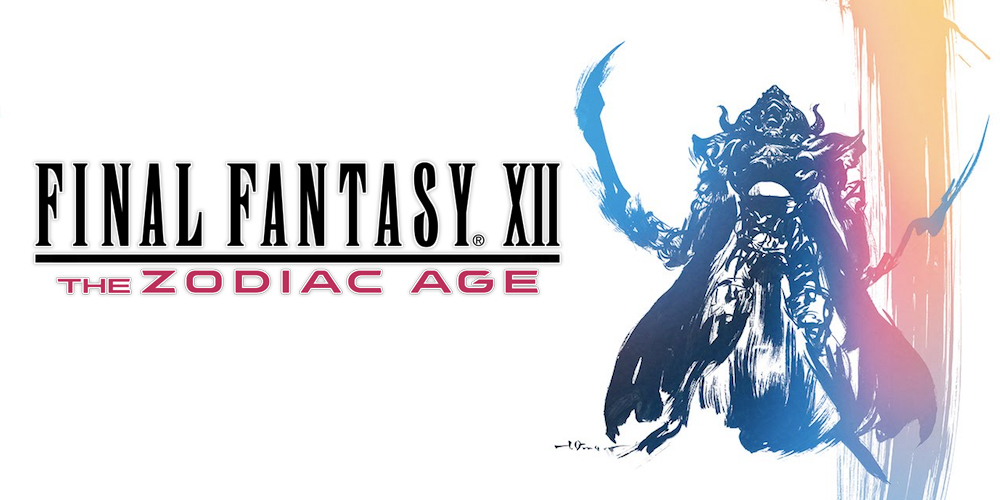
As a long time fan of the Final Fantasy series growing up, I never had a chance to play Final Fantasy XII because I didn’t own a PS2. I can still recall when it was originally released and being hesitant about how well it would be received. Square Enix made a lot of changes to their usual formula, going from turn-based combat with random encounters to active dimension battles utilising ATB and visible enemies on the map, but many people seemed to really enjoy the new changes, and it was praised for its freshness. When it was announced last year that they were going to remaster the international version of Final Fantasy XII and release it on PS4, I felt it was finally my opportunity to play this game and see for myself if it lived up to what I had heard all those years ago.
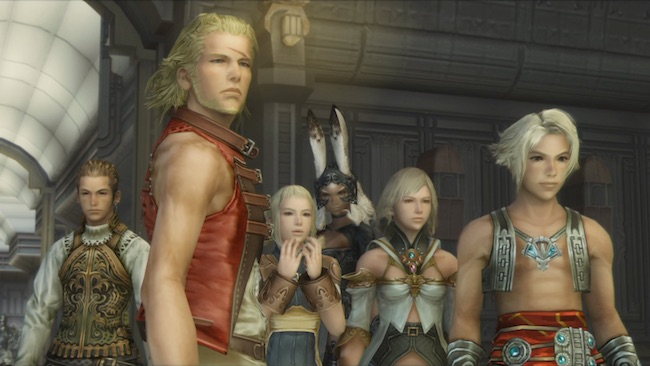
I approached Final Fantasy XII: The Zodiac Age as a newcomer, having come in with some knowledge on how I thought the various systems operated but with no practical application, as well as some background information on a few of the characters. I tried to stay away from looking anything up and aimed to play this game completely blind with no extra help to see how easy and accessible it is for others like me who are just starting to play.
Set in the world of Ivalice, the story focuses on the small kingdom of Dalmasca, caught between the warring empires of Archadia and Rozarria. As a result, their princess is forced into exile in order to survive while she searches for a way to reclaim the throne and seeks revenge for her father and husband who were killed in the conflict. The plot is widely politically focused, with all of the main playable characters having been affected by the struggle in some way. They’re a bit of a ragtag group with different motives but band together with the common goal of trying to bring peace back to the world.
I’m sure I’m not alone in this, but I found the narrative difficult to follow at times because the writers chose to use older language and sentence structures combined with many antiquated and fictional terms that are often repeated without a very detailed explanation, particularly during cutscenes where a lot is happening in quick succession and conversation is flowing. Upon finishing the game, I decided to read a synopsis of the plot to make sure I hadn’t missed anything because I was unsure of some sections and there were a couple of things that were clarified for me in doing so. Regardless, I still didn’t find the plot overall to be particularly interesting as it’s a fairly standard story structure and there aren’t really any big twists that are surprising.
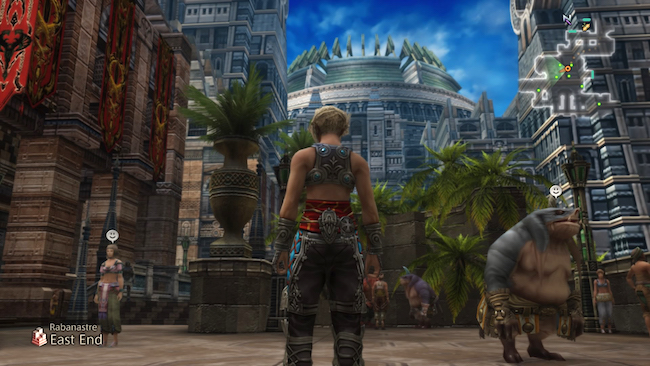
Despite my issues with the plot, the characters helped push that along, and I found myself growing attached to some of them. Balthier and Fran, the sky pirate duo, are the characters I came into FF12 knowing the most about, and I quickly understood exactly why they’re so popular with fans. It honestly felt like they were the protagonists for the most part; Balthier even quips that he’s the leading man multiple times throughout the adventure, and they appeared to receive the most backstory throughout the game. Their personalities are well developed, and you slowly learn the secrets from their pasts that they are trying to keep hidden away.
Initially, I thought that it was strange for Vaan, the small-time thief with dreams of becoming a sky pirate, to be labelled as the main character when he doesn’t develop that much over the course of the plot. Although, I eventually came to realise that Vaan and Penelo’s place in the cast is to represent the average people who don’t have ranks. They aren’t supposed to be great warriors or particularly knowledgeable, they’re just regular old humes, especially compared to Ashe, the exiled princess, and Basch, the disgraced captain of the knights. However, even with this allowance, I wouldn’t have positioned Vaan as the protagonist of this game.
The License Board is one of the most well-known features of FF12, and I was eager to get my hands on it. The idea as a concept is interesting: everything the characters can do, wear, attack with, and so forth has a tile on a board, and you won’t be able to use things unless you purchase the appropriate tile. Originally, all the characters were on one large board together, and you could choose anything for any of them. In the remaster, however, they’ve brought in the Zodiac Job System from the international version which splits the large board into twelve smaller sections to make them more specialised for particular jobs.
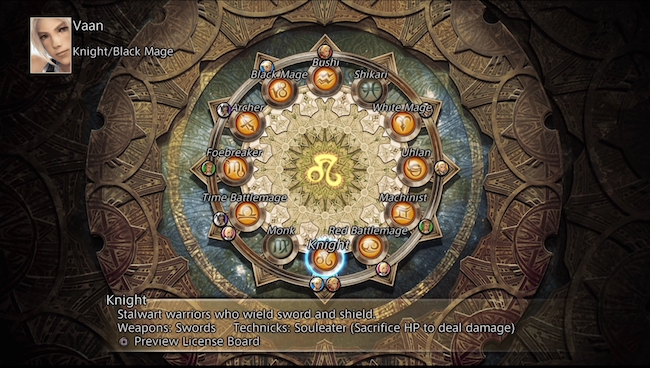
The reason for implementing this is because a lot of players ultimately ended up with parties who were all very similar to each other as everyone eventually learns the same skills. In turn, Square Enix decided this would be a good way to create diversity since any character can have any job without restrictions, and, in the remaster, they are allowed to have two jobs each, using up all twelve license boards. Even so, I was disappointed to learn that even though the individual boards are specialised, they’re not particularly unique from each other. I was hoping that there would be a special skill for each job, but I found that a lot of skills and spells in one job would appear in others, even if the first job had it listed as their speciality. This may be viewed as a minor gripe, but it made it feel less unique to me, and I feel like they missed an opportunity to truly make the jobs stand out from each other.
Gambits are the other big selling point of FF12; the ability to program the AI of the characters to act however you would like them to behave using a series of “if/then” commands in a prioritised list. If you programmed it right, you could just walk around and have your party fight for you upon encountering enemies without pushing a single button. It’s definitely an interesting concept that I was eager to try out for myself but was once again disappointed by the options. There were several times that I thought of something I wanted to make as a gambit but couldn’t work out any way to do it that made sense with the options provided. Now, maybe I’m just bad utilising this system and didn’t understand it well as others seem to make it work to their needs. But again, as a newcomer to this game, it’s not precisely explained to you how it works. There was a lot of trial and error where sometimes I still didn’t understand why it wasn’t working, before I just set up some basic commands and didn’t really change them, preferring to do any of the more complex actions manually as I needed them.
I also found it quite inconvenient that they removed the ability to use magicks and items from the main menu. Instead, all of those actions need to take place in real-time using the battle menu and waiting for the ATB to charge. This is especially annoying when trying to heal up after a difficult battle and having to stand around while waiting for Cure to be cast again and again. If you have multiple KO’d members this is even worse as you have to switch them into your party to cast Raise or use a Phoenix Down on them. I understand that they wanted it to have an active feel, but it would have been much easier and convenient to be able to control all of that from the main menu.
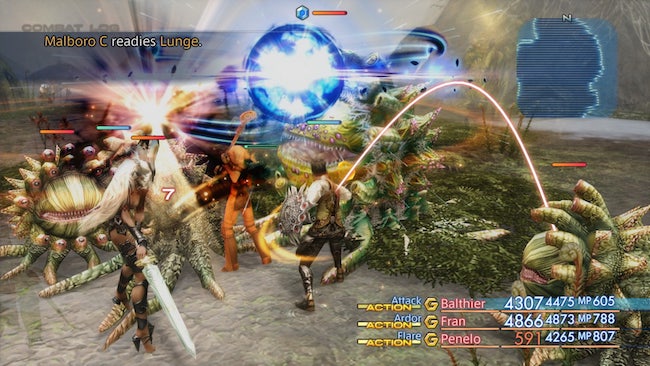
Travelling through Ivalice feels a lot like running around an MMORPG as there is no overworld; instead, you move through a series of maps for the different areas until you reach a new zone. The areas are incredibly large and can be a bit tedious to run through, especially when there are always enemies several steps away just waiting to attack if you get within their line of sight. Thankfully Square Enix added a Speed Mode option in the remaster to help players get through these sorts of areas faster. With a press of a button, you can increase the game to 2x or 4x normal speed, which puts everything in fast-forward and lets you travel across the terrain in no time at all. I personally found this useful when going through areas I had already been through where the enemies were weak, as well as when fleeing from battle and trying to get out of an area as quickly as possible.
Travel wasn’t without some convenience in the original game, though, as players were given the ability to teleport between select orange save crystals throughout the world (as opposed to the standard blue). There is essentially one for each main area so you can always come back to any previously visited zone. One issue I had with the game, however, is that if you ever find yourself running low on health on one of the many maps within an area, there is no easy way to get out and back to safety. In order to use the orange save crystals to teleport too, you also need to have teleport stones in your inventory, which feels redundant as the orange save crystals are already rare and easily could have charged a fee if the game wanted to limit players’ usage. It would have been much better if teleport stones were instead used as a sort of “escape rope” to return to the closest town if you ever found yourself in a bad situation.
Another new feature added to the remaster is auto-saving, which is an attempt to remedy the previously known issue of not having enough save crystals. Basically, the game auto-saves every time you enter a new screen, and while useful, I don’t think it entirely solves the underlining problem. Strategically placing more save crystals throughout Ivalice would have made exploring the expansive environments much more enjoyable as save crystals are also the most convenient way to replenish resources once they’re depleted. I was often hesitant to stray from the main objective if my party was low on health and MP in hopes that I might come across a save crystal. This became a real problem towards the later parts of the game, where single maps are long and filled with hordes of strong enemies who can cast a bevvy of status effects. Sometimes the closest save crystal would be multiple screens away, and if you died without reaching a new screen, there would be no way to recover that progress, and you would have to start again.

You could potentially counter this problem by stocking up on lots of healing items, but that’s not really an ideal solution. Money is hard to come by in FF12, with the majority of gil being found in chests or obtained by selling loot, so it’s always a choice of what to prioritise in regards to purchases. I personally decided to invest all my money on magicks whenever new spells became available at the store because it felt essential. Although, in saying that, I soon realised that not all magicks and technicks are actually for sale in stores. There are some that you need to find throughout the world hidden in chests. I got to the end of the game and was still missing a number of spells, but I had no idea where they were without looking it up.
I also personally found the constant micromanaging of the license board, then having to buy or find the magick, technick, weapon, equipment that it allowed you to use, then make a gambit for it which would work in the rotation with your other gambits to be a bit of a headache. I know that my party ended up being under-equipped because I just couldn’t afford to keep up with giving them the best gear when everything was so expensive. As mentioned, money isn’t easy to come by unless you do some grinding, though Square Enix did add an all new Trial Mode to the remaster which helps if you’re looking for a convenient way to do this. It’s a challenge mode made up of 100 consecutive battles that increase in difficulty, but you receive great rewards every ten levels, and there are always a couple of chests on the battlefield that can help get you through.
Last but by no means least, it’s not a remaster without improved graphics and audio! I did some research in this regard having not played the original game and decided to watch some videos of the original for comparison. I can definitely see the improvements they have made, and it makes a difference, especially during cutscenes where jagged textures would really stand out. In particular, I noticed that they remastered the vocal tracks of the original actors which make it sound a lot cleaner and overall a more pleasant listening experience. They even added the ability to toggle the voices between English and Japanese depending on your preference. The soundtrack is also newly recorded to be more in line with today’s standards, but again you’re given the ability to toggle to the original soundtrack for those who preferred that version.
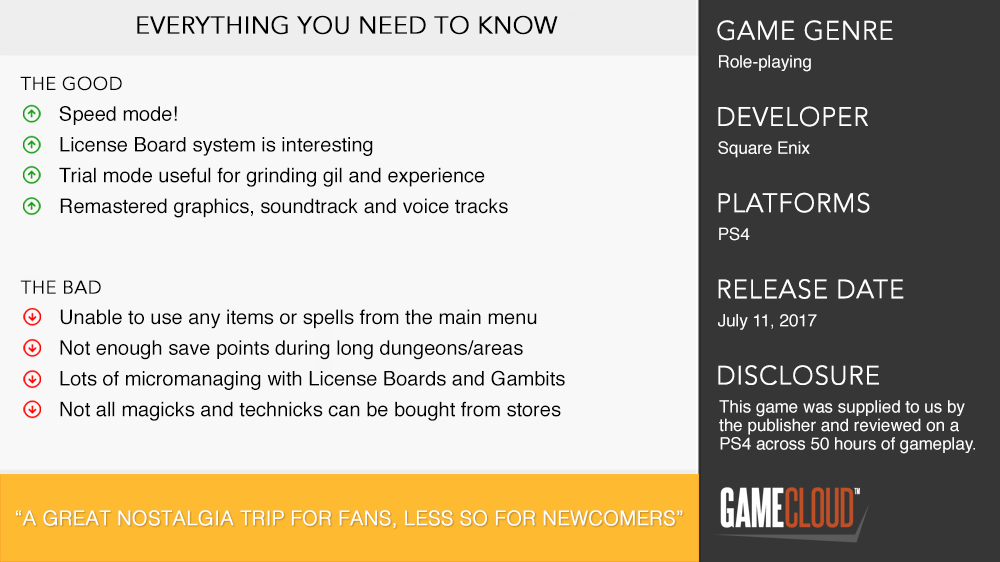
Final Fantasy XII: The Zodiac Age is a well-loved instalment in the franchise that has been remastered beautifully, but as a newcomer to the game there are several areas I felt were lacking and could really have been improved with this new release. There are plenty of things to do and places to explore in the sprawling world of Ivalice, and maybe with more time and practice I can learn to understand the license board and gambit systems better. However, as they are, it’s not very welcoming to those coming in without prior knowledge. Even though I overall had a mostly positive experience with FF12, I can’t say that I would recommend it to everyone. If you’re a first-time player, you’re probably going to need a guide or to look up a lot of things to get the most out of it, but if this still sounds like the sort of game you’re interested in playing then give it a shot. Despite its flaws, maybe you’ll really enjoy it as plenty of others do.











